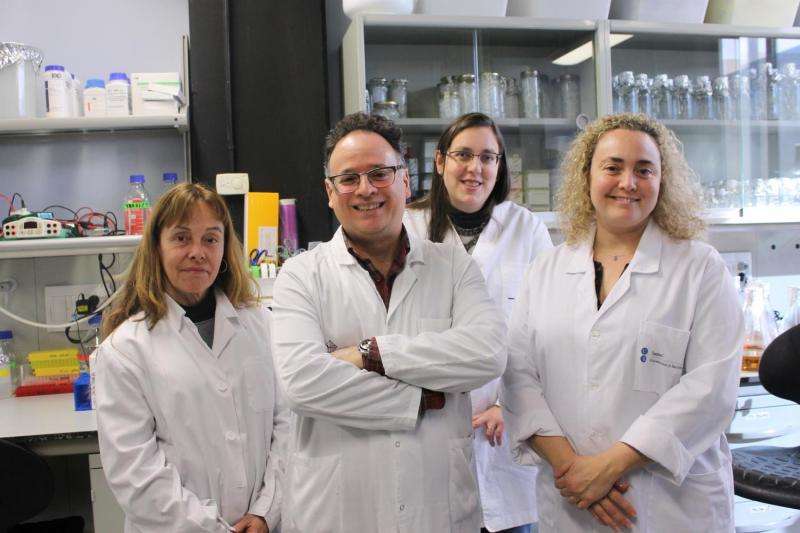From left to right: Montserrat Abella, Pablo Fuentes-Prior, Marta Nadal and Eva Estébanez. Credit: PCB
A research team has studied for the first time the 3-D structure of the homodimeric androgen receptor ligand-binding domain, a structure that eluded researchers for years. This new structure of the nuclear receptor explains more than forty mutations related to prostate cancer, as well as disorders such as androgen insensitivity syndromes.
The human androgen receptor is a key protein in the regular development and activity of the prostate in response to male hormones such as testosterone. The deregulating activity of the receptor is directly related to the carcinogenesis of the prostate gland. "The resolution of its three-dimensional structure is an essential key to diagnose and predict prostate cancer, as well as monitoring patient's resistance to medicine," says researcher Eva Estébanez Perpiñá.
The androgenic receptor was and still is the central target of the fight against prostate cancer. Identifying its homodimeric 3-D structure suggests new therapeutic strategies. "Actually, we started exploring the design of a new generation of drugs in collaboration with pharmaceutical companies in order to step toward a precision medicine for prostate cancer," says Estébanez Perpiñá.
This work, published in Nature Communications, describes the molecular bases of mutations detected in prostate cancer patients and also in those with androgenic insensitivity syndrome (AIS), a disease caused by the mutations in the X chromosome that create a resistance to male hormones.
New generation of drugs to treat prostate cancer
At this moment, prostate cancer is the most common malignant tumour among men from industrialized countries. In Catalonia, the number of cases has grown dramatically in recent years, and studies show that more than 30,000 people will be diagnosed with this neoplasia by 2020. The main difficulties to treat it include high clinical heterogeneity and the quick appearance of resistance to commonly used drugs. So far, treatments have focused on known compounds such as antiandrogens, which act on the androgenic receptor and stop androgen action.
The 3-D structure presented in this work describes allosteric communication between the functional areas of the binding domain in the androgens—that is, between the elements of the receptor that are in indirect physical contact and which are essential for the regular and pathological functioning of the nuclear receptor. "These interconnections, identified in the dimeric form of the receptor, suggest a complexity of activity which is much bigger than previously known, and with a direct impact on drug design that can remove secondary effects caused by currently used drugs," says Fuentes Prior.
The researchers show for the first time in high resolution the dimeric structure of the binding domain in human androgen receptor hormones, and they prove this structure is essential for the biological activity of this important nuclear receptor. "The new drugs to be developed out of this discovery will block the physiopathological processes coming from the union of these hormones, instead of competing with the union of natural hormones, as current antiandrogens do," said Fuentes Prior.
More information: Marta Nadal et al. Structure of the homodimeric androgen receptor ligand-binding domain, Nature Communications (2017). DOI: 10.1038/ncomms14388
Journal information: Nature Communications
Provided by University of Barcelona





















